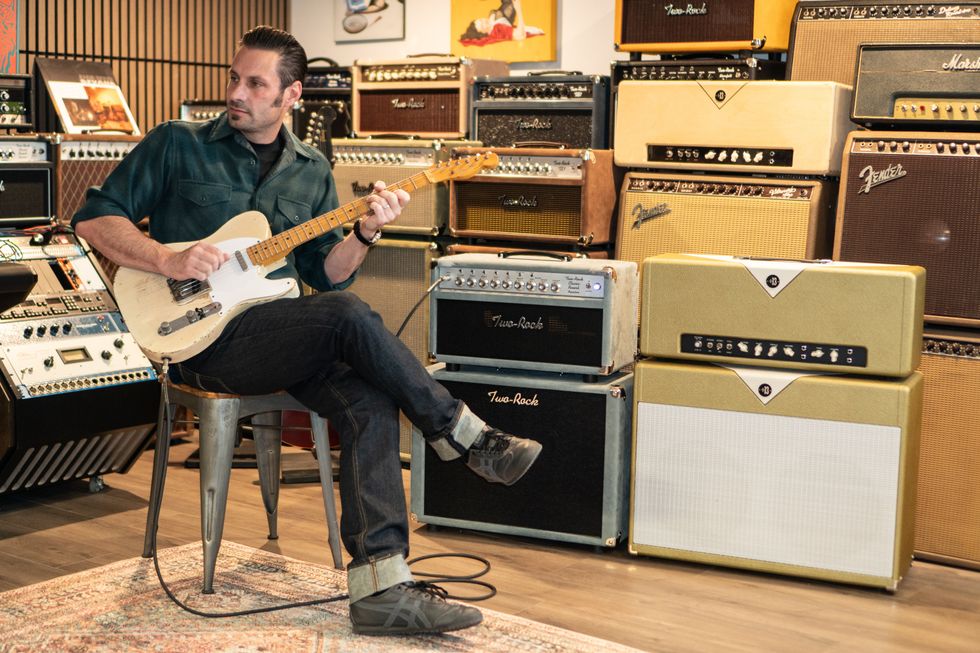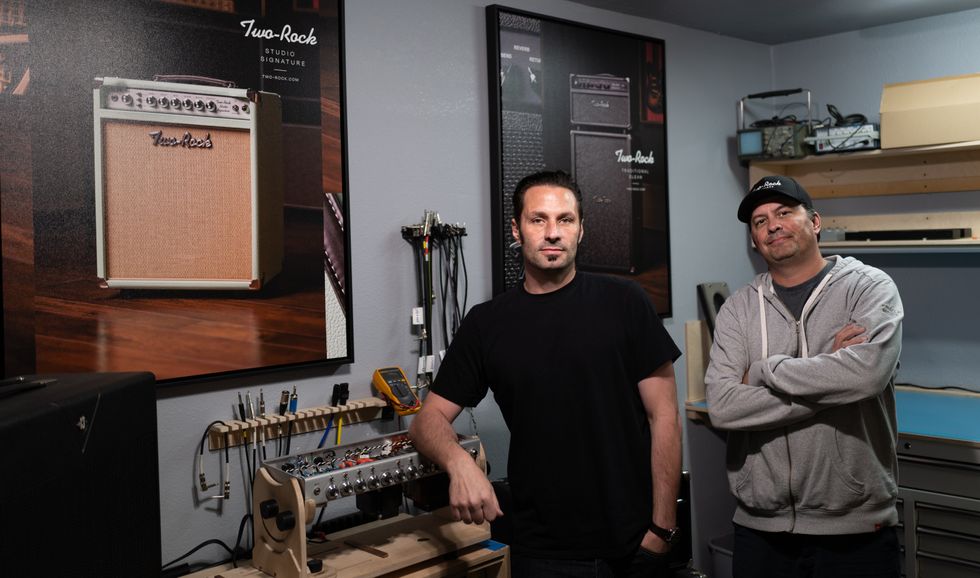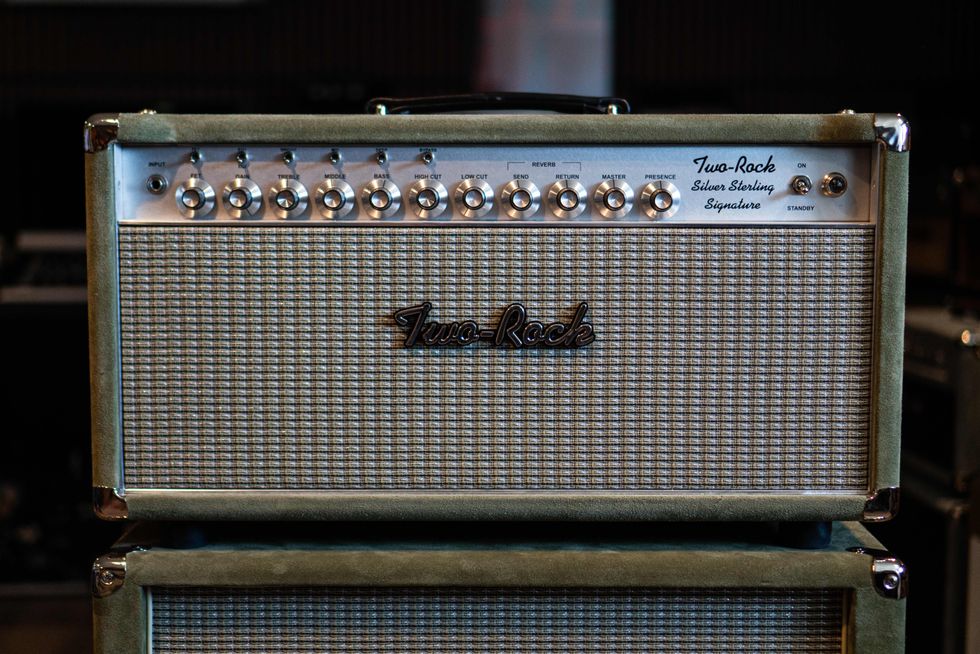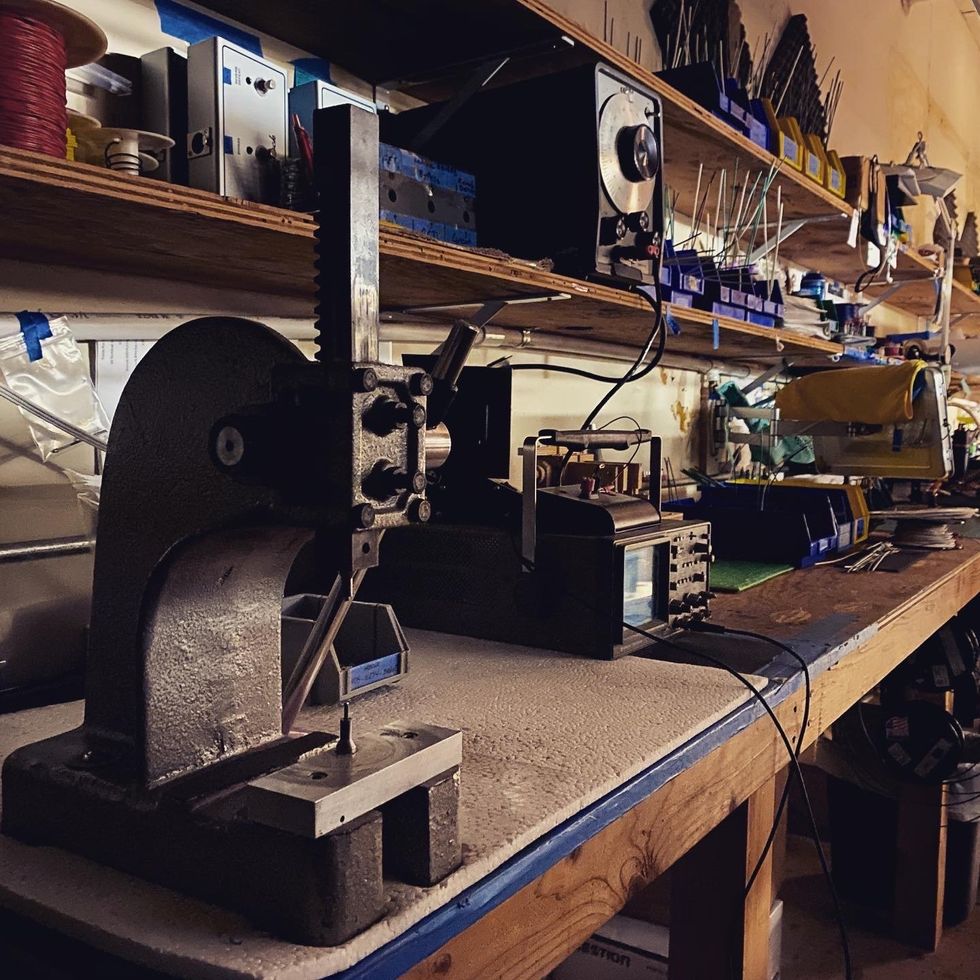As a teenager, DeCola fell in love with surfing, but growing up in Indiana … no ocean. So, skateboarding became his passion. When a surf park called Big Surf—replete with rideable waves—opened up near his sister, who he was visiting during spring break at Arizona State University, she treated him to a day at the man-made sea.
Jim DeCola paid for his first guitar with his nose.
“When the first wave came, it scooped us all up, and I was tumbling under and something hit me bad,” he recounts. “So, I’m in a daze, and my sister runs up to me and says, ‘Oh my god, you have a bloody nose!’” When DeCola looked in the bathroom mirror, his nose was broken and the skin was split. The surf park’s medic sent him to a hospital. “Whatever the bill is, give it to us and we’ll double it,” DeCola recalls being told. “Just please don’t sue.” When a check for $880 arrived, his mother suggested he use it to buy the electric guitar he was pining for. “I ended up with a Gibson SG, because George Harrison had one, but they didn’t have a cherry red one, so mine was ebony.” He also got a Roland Cube practice amp because it had a master volume. “I still have both, and it’s still a great little amp and a great guitar. And that,” he says, “set me on my course.”
It’s been an epic journey in guitar creation: from his apprenticeship at a Lansing, Illinois, shop—which led to a dramatic and well-chronicled bridge fix for Randy Rhoads—to his years with Peavey, Fender, and now Gibson, where he is R&D manager and master luthier. DeCola blanches a bit at the master luthier title, observing that he’d prefer, simply, “guitar guy,” but that’s like calling a tiger a cat. DeCola is an apex builder. Instruments he designed are world-renowned and he’s collaborated with an enviable list of greats that includes Eddie Van Halen, Paul McCartney, Slash, Adrian Vandenberg, Rudy Sarzo, Neil Schon, and Randy Jackson.
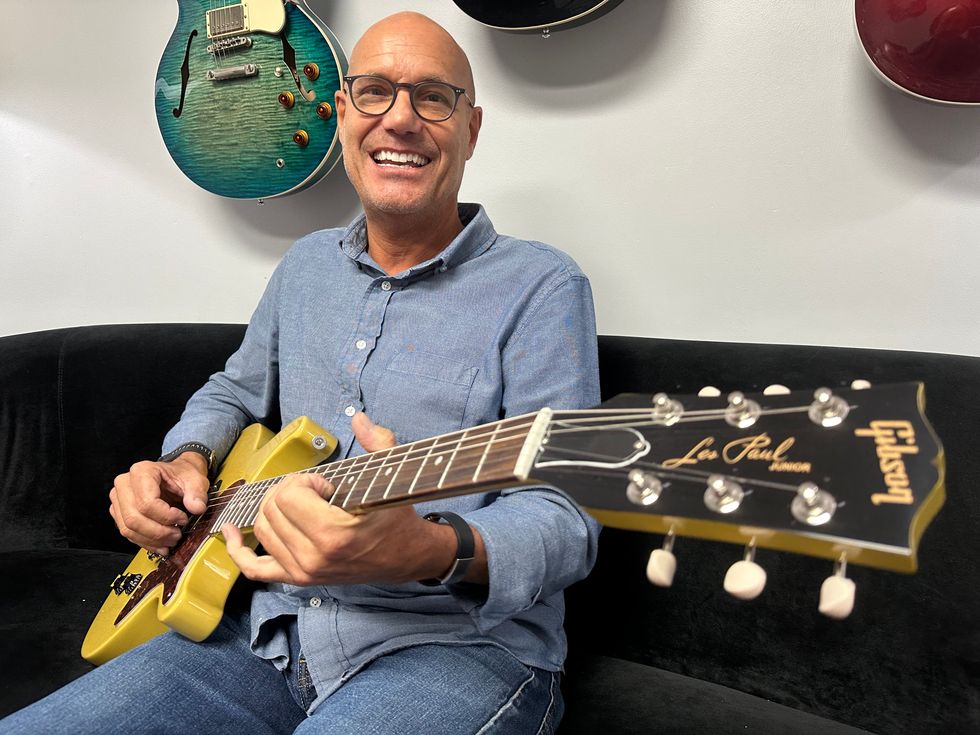
Jim DeCola at the Gibson USA offices in Nashville. He spearheaded the company’s current two-pronged product orientation, with original and modern instrument lines.
Photo by Ted Drozdowski
In the Beginning…
DeCola’s family was musical. His dad played many instruments but trumpet was his main squeeze, and his older brother and sister exposed Jim to the Beatles, Stones, Hendrix, Cream, and other deities of the ’60s guitar-rock canon. Thus fueled, at 15, in his second year of wood shop, he decided to build a guitar. Inspired by a photo of Scorpions’ Matthias Jabs, he settled on an Explorer body shape. A friend who already played guitar detailed where the bridge needed to go and what parts were required, and DeCola reverse engineered from there. He even cut the pickguard from a sheet of gray smoke Mirrorplex. But despite two years of electronics classes, he opted to bring his creation to the Music Lab, that guitar shop in Lansing, where he was taking lessons, for the wiring.
“The guy who did repairs wired it up for me, and when it was ready he called and said, ‘Hey, I want to talk with you when you come in,’ ” DeCola recounts. “He asked me to apprentice with him. It was learn while you earn, and while I did learn some stuff from him, really, I was wet sanding guitars and doing that kind of grunt work.” DeCola was at Music Lab part-time for 18 months, and graduated from high school just as the tech left. The owners of the store asked Jim to take over, and, as Suetonius told Caesar, the die was cast.
In January ’82, a caller made DeCola think he was being pranked—until he became convinced it really was Randy Rhoads and Rudy Sarzo’s tech Pete Morton. They explained that Bruce Bolen, then at Chicago Musical Instruments, had suggested him to fix Rhoads guitar in time for the night’s Ozzy Osbourne performance. DeCola grabbed his tools and drove through the snow for 50 miles to the Rosemont Horizon arena, where Rhoads was having trouble keeping the vibrato bridge on his polka-dot Sandoval custom V in tune. After a quick round of introductions, DeCola took apart the vibrato bridge and used a technique inspired by G&L guitars, deleting two of its bridge’s four screws and cutting a pivot with a V-file to countersink the bridge plate. Next, he was treated to a soundcheck of “Mr. Crowley” by Rhoads, Sarzo, and drummer Tommy Aldridge. As the opening act played, Rhoads asked DeCola to make the vibrato “a little slinkier,” and he completed the mod just before Ozzy’s downbeat. DeCola—still in his teens—was standing just off to the side when the iconic photo of Ozzy carrying Rhoads that appeared on the cover of the 1987-released Tribute album was taken.
Six years later, DeCola received offers from Kahler and Peavey, and he opted to relocate to Meridian, Mississippi, to work with Hartley Peavey as his R&D tech. “I learned a lot,” he reflects. “Hartley was a great mentor. At any time, I’d have a stack of books and magazines, or just single pages ripped from magazines, a foot high on my desk, and he’d expect me to read and give him a report on everything,” says DeCola. “Sometimes it was related to guitars, amps, and effects; sometimes it might be antique radios.” After a few years, DeCola was promoted to supervisor of guitar engineering and began designing instruments. DeCola minted some of Peavey’s most lauded guitars, including the Tele-like Generation, with dual humbuckers, a mahogany body and neck, and a 5-way switch. That guitar gave the company a toehold in the country music market, but was also embraced by Steve Cropper and Dave Edmunds.
“We looked at each other and said, ‘The decade of the “superstrat” is over.’”
Every Best Les Paul Sound
Another pivotal experience during his years at Peavey happened at a summer NAMM show in Chicago’s McCormick Place, when a celestial Les Paul tone suddenly emerged from the exhibition hall’s PA system. “It was ‘Sweet Child O’ Mine’ by Guns N’ Roses,” says DeCola, “and we’re looking up thinking, ‘Who the hell is this?’ It was every best Les Paul sound wrapped up into one. We looked at each other and said, ‘The decade of the “superstrat” is over.’ And it really was.”
That inspired DeCola to create the Les Paul-Tele-style hybrid Peavey Odyssey. He also worked with Adrian Vandenberg on set-neck and neck-through versions of the Dutch guitarist’s signature models, and a host of other artists—including Eddie Van Halen. Peavey’s artist relations head heard that Van Halen had a falling out with Ernie Ball Music Man and sensed opportunity. DeCola quickly made a prototype inspired by Eddie’s EBMM signature model and took it to a gig in Florida, where the band was kicking off the Balance tour. “Eddie rehearsed with it and said, ‘Okay, now I know you can do it; let’s come up with a design.’”
During the development process, DeCola learned that Eddie’s son Wolfgang had a birthday coming. So, as a gift for Wolfie, he decided to make a 3/4-size example of his signature concept for Eddie. Mid-build, Eddie made a surprise visit to Meridian. DeCola invited EVH into his office and showed him Wolfie’s guitar.
“I thought this would be the direction we’d use for your new model,” DeCola explained. “He said, ‘Yeah, I love it! Just make it full size, then.’ And for the headstock, Eddie had done some napkin drawings in the hotel that were like Flying V’s, but smaller.” That wouldn’t work, thanks to the U.S. Patent Office. More ideas were exchanged. DeCola was coincidentally working on a new build for himself at the time, with a three-to-a-side headstock. He painted that headstock black, and then sanded a scoop in its tip. And that was it. Eddie was happy. DeCola wanted to get a prototype into Van Halen’s hands as quickly as possible, so when he found out the virtuoso was leaving Meridian the next day after lunch, he worked through the night.
“When he showed up the next morning at 11 a.m., I was just tuning it up,” DeCola recalls. “It was raw wood, but he played it and said, ‘That’s it.’” Thus, the Peavey EVH Wolfgang was born. “After that, the engineering took longer than making the guitar, because I had to do the blueprints and totally spec out everything,” DeCola adds.
Another important encounter he had in Meridian was with the blues historian and record collector Gayle Dean Wardlow, noted for, among other things, finding the death certificate of Robert Johnson. After they met, DeCola started going to Wardlow’s home weekly to talk about the roots of the genre he’d begun studying as a young player, listen to rare old 78s, and absorb the techniques preserved in their shellac. That study paid off. Hearing DeCola play metal-bodied resonator guitar is a high-order experience, although he also sounds terrific rocking the hell out on a Les Paul. DeCola is humble about his playing, but, really, he doesn’t need to be. “It’s a great release, and great therapy,” he says.
DeCola’s tenure at Peavey ran its course. “I was making P-90 and 12-string versions of existing guitars, a 12-string baritone … and they were turning my operation into a custom shop, which I didn’t want to do, because that’s just low-volume manufacturing. I wanted to stick with designing new stuff,” he says. “I wanted a change. It was five years with a lot of pressure. I wasn’t getting credit for designing and building Eddie Van Halen’s guitars. So, I went to Fender in Nashville, who had what they called the Custom Shop East at the time.”

“Musicians and skaters have the same kind of soul, the same mindset,” DeCola says. “It is something you can do by yourself, as a form of expression, but when you’ve got your crew and you’re skating, it’s like being with your band.”
Photo courtesy of Jim DeCola
“I came up with the idea of teaching people how to use things that every guitar player is going to have around the house for tools—coins or picks—and MacGyver their instruments.”
On to Gibson
There, he worked with Bruce Bolen and pickup guru Tim Shaw. But after Bolen retired in 2011 and Fender decided to close that Nashville location, DeCola found out about openings at Gibson and applied. In June, he was hired as master luthier.
“Gibson’s been a great ride,” DeCola attests. Although it hasn’t always been easy. When DeCola came onboard, the notoriously controlling, sometimes-volatile Henry Juszkiewicz was CEO. “It was fine for me, because Henry respected me, but it was an environment where I felt I had to be measured in my responses,” he says. There were also notorious design gaffes, like “robot tuners” and the dreadful Firebird X—both pet projects of Juszkiewicz that almost literally no one else, especially customers, desired.
“I got blamed for some of that stuff, but I was just the messenger,” DeCola says. But as James Curleigh and, now, Cesar Gueikian took over Gibson’s leadership, DeCola had an opportunity to proactively get his thoughts on the direction for the company’s products before more receptive CEOs.
“I made a bullet list and at one point had maybe 40 things on there, like going back to a thin binding on certain models and changing features,” he relates. “But my main message was, ‘Give the people what they want; we’re not here to dictate what people want.’” Many of DeCola’s ideas were manifested in the roster of guitars at the Gibson display at NAMM 2019—instruments that honored and built upon the company’s legacy. DeCola also had the idea of splitting Gibson’s model line into original and modern categories. “My concept was, we have the original models, which we’re determined to improve, and the modern line where we could have locking tuners, push-pull pots, and blueberry burst finishes—features that aren’t rooted in the golden years of the ’50s.”
Gueikian embraced that practice for Gibson USA and the Custom Shop, and expanded it to the acoustic Custom Shop in Bozeman, Montana, and to the Mesa/Boogie amp line. But DeCola was already on the case with amplification. Before Curleigh stepped down, he’d asked DeCola to look at Gibson’s amp line, and, again, DeCola looked back and forward at once. Inspired by his personal collection of vintage Gibson amps, he mapped out a new product line for 10-, 20-, and 40-watters. “I based my thinking off the greatest hits of those classic amps, and focused on the Falcon, because I have a ’62 Falcon, and when I looked into its history, the revelation was that it was the first amp with both reverb and tremolo,” he says. “So, I thought that would be a cool amp to make.” Then Gibson bought Mesa/Boogie under Gueikian’s stewardship, and the project went to that company’s Randall Smith, who created a stellar original design. Gibson unveiled the power-switching Falcon 5 (which won PG’s coveted Premier Gear Award) and Falcon 20 in January 2024.
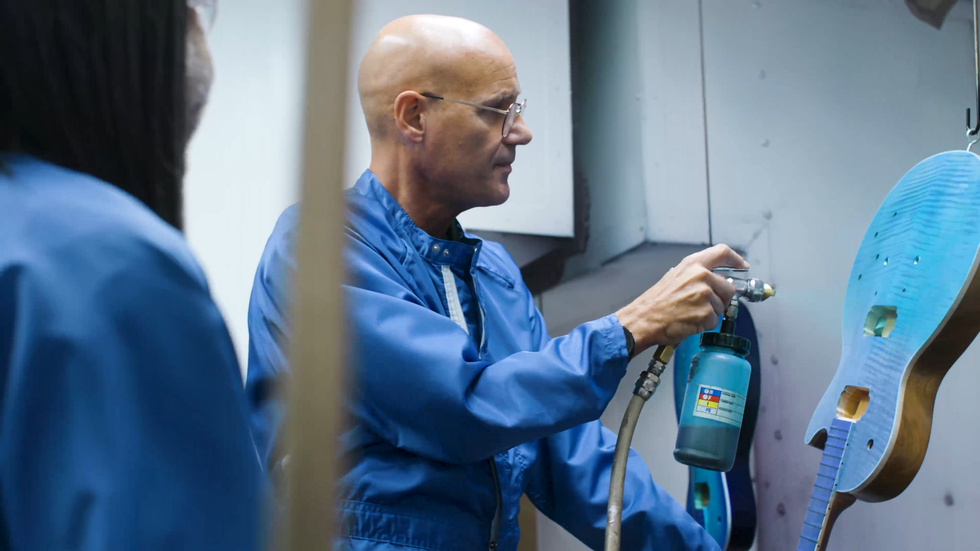
DeCola is skilled in every aspect of guitar building, including working in the spray shop, where he is seen here training the gun on a model year 2024 blueberry burst Les Paul Studio.
Photo courtesy of Gibson
Mr. Fix-It
While the profile of most people in the guitar industry went down during the pandemic, DeCola’s went up thanks to a series of how-to videos he made for Gibson’s YouTube channel. They cover such topics as how to adjust action and pickup height, and how to do a proper setup. “I wanted to do something for the guitar community when things were shut down, so I came up with the idea of teaching people how to use things that every guitar player is going to have around the house for tools—coins or picks—and MacGyver their instruments,” he says. These videos have hundreds of thousands of views, and have given him a kind of celebrity status that’s rare among luthiers.
When asked what makes a great guitar, including the signature models he’s worked on at Gibson for Paul McCartney, Slash, and others, DeCola talks about achieving a commonsense, holistic balance of design, materials, and craftsmanship. He adds that there is no shortage of fine instruments now available, and that, moving ahead, he sees the kind of balance between tradition and invention that he has promoted at Gibson remaining its norm. “There are a lot of boutique builders and trends like 7- and 8-string guitars, fanned frets, and different scale lengths today,” he notes. “Some of it can be cyclical. There was a period in the ’80s and ’90s, for example, when a lot of people were adopting 7-strings, and now I see a lot of them again.
“Gibson was built on innovation,” he continues. “Orville Gibson, our founder, got his first patent creating a mandolin built completely different than other mandolins. Prior to that, they were typically gourd instruments, but he applied the carved back and top method from the violin and cello. And with the jazz-box electric guitars, there were so many Gibson innovations, like the adjustable neck and bridge, the humbucking pickup…. But because we’re a legacy company, we have to tread a bit lighter on some of the innovation, which our previous leadership was too forward on, with features the market wasn’t ready for. But in defense of that, I’ll go back to our heritage instruments. The Flying V and Explorer were all designed out of the space race, but initially commercial flops—too ahead of their time. So that’s why I wanted to split the model line—so we have the latitude to come up with some new things, but can still honor what’s expected of Gibson. Right now, we’re looking at some innovation in electronics and other features we will be bringing to the market.”
Now in his early 60s, DeCola is also still working on his skateboard moves. He tries to get to Nashville’s municipal Two Rivers Skatepark and Rocketown once a week. There, he’s found a coterie of fellow veteran skaters—many of whom are also in the music business, as players, producers, and engineers. “I’d say musicians and skaters have the same kind of soul, the same mindset,” he says. “It is something you can do by yourself, as a form of expression, but when you’ve got your crew and you’re skating, it’s like being with your band. It’s even more fun, and it inspires you. It can make you better.”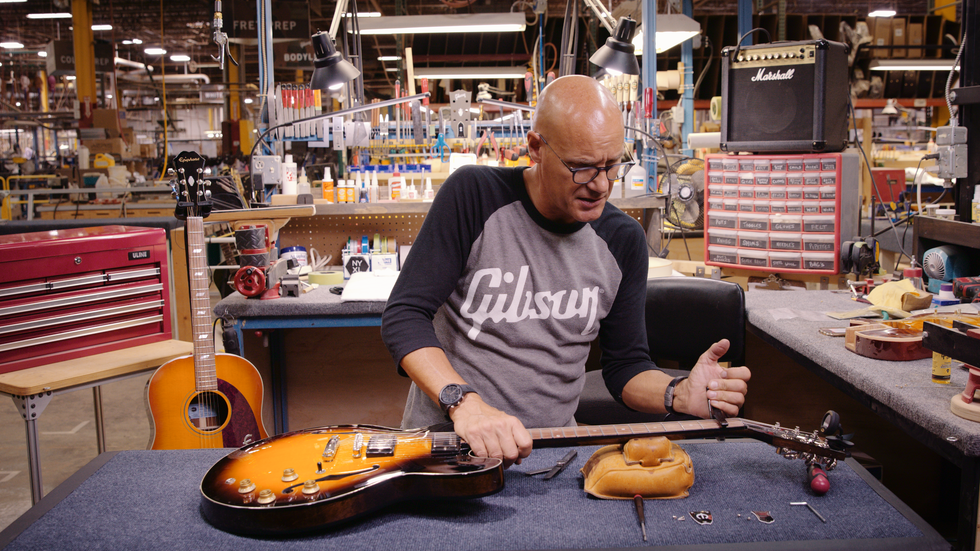
DeCola performs a neck adjustment on an ES-335.
Photo courtesy of Gibson
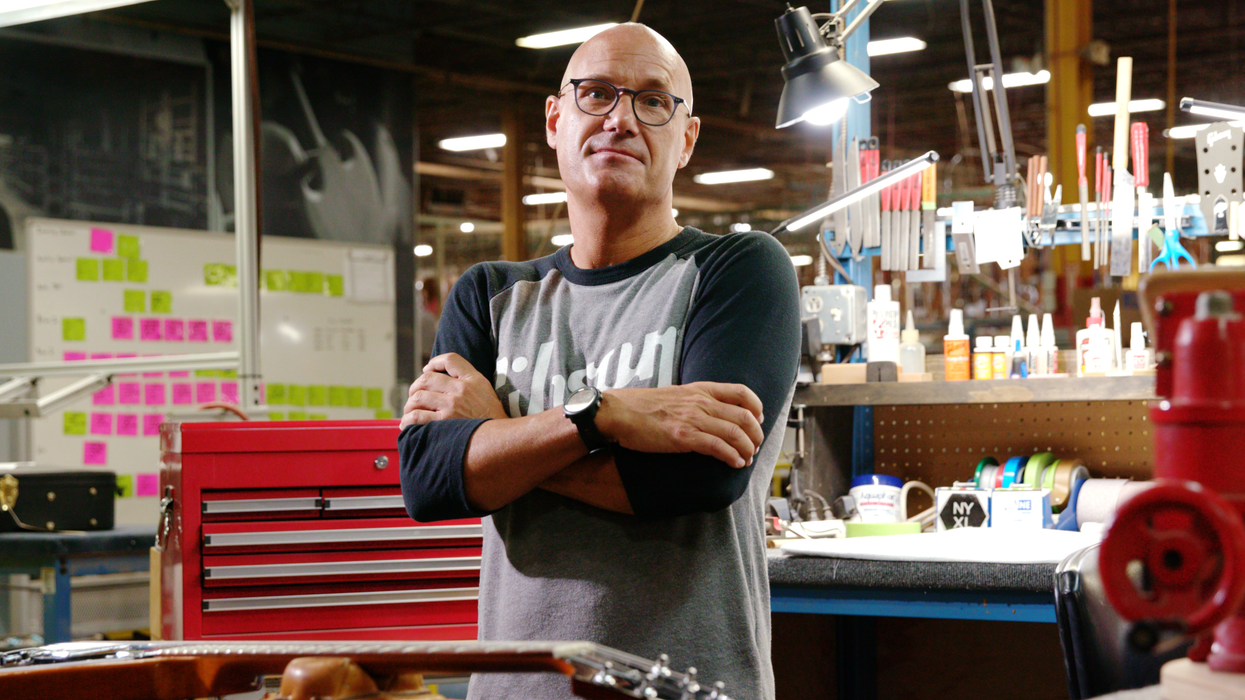




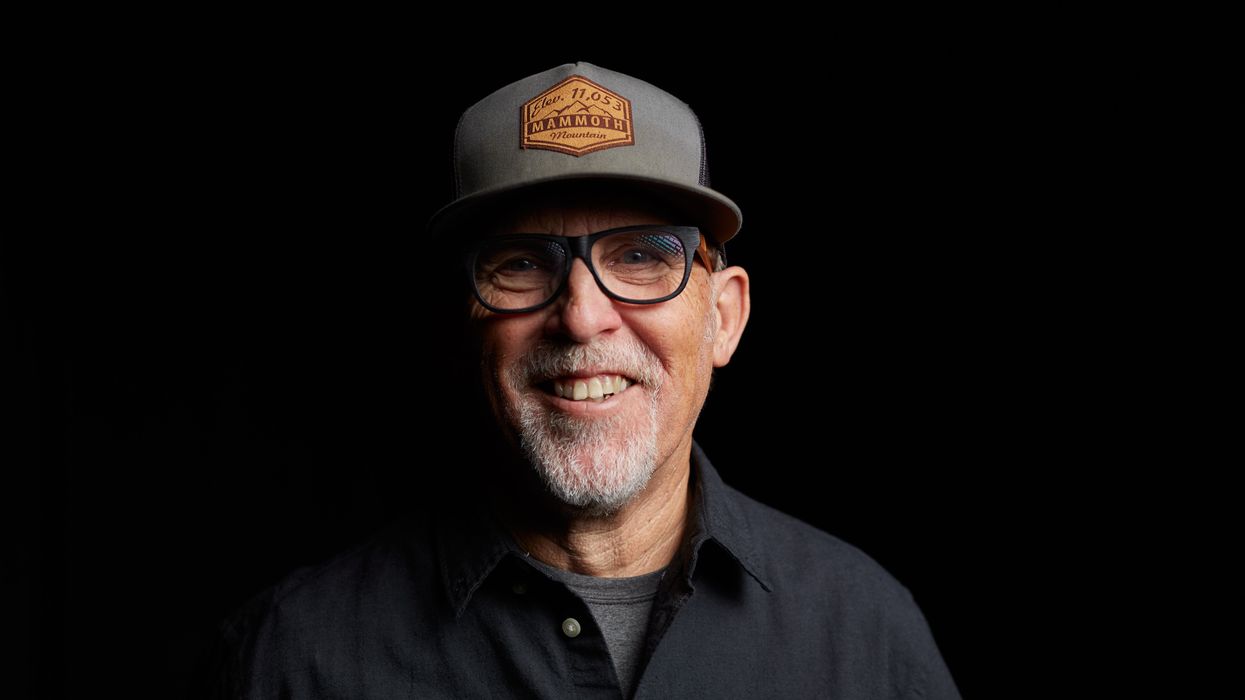


![Devon Eisenbarger [Katy Perry] Rig Rundown](https://www.premierguitar.com/media-library/youtube.jpg?id=61774583&width=1245&height=700&quality=70&coordinates=0%2C0%2C0%2C0)














